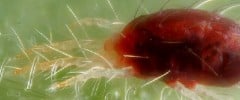How to Identify and Manage Mealybugs

Mealybugs are a big problem for interior landscapes. They love tropical foliage, especially plants such as pothos and ivy, where they often go unnoticed. Mealybug populations do not explode overnight—they’re usually present for a long time but in small numbers. At these early stages, they can be tricky to spot because of their tendency to hide in plant cracks and crevices. Understanding how to identify, manage, and prevent these pests is crucial to keeping your clients’ plants healthy and thriving.
Why Are Mealybugs So Destructive?
Mealybugs damage plants by injecting toxins while feeding, causing deformed growth. As a type of soft-scale insect, they also excrete honeydew, a sticky substance that attracts unsightly sooty mold. This honeydew can also spread to walls, furniture, and floors, leaving a sticky mess. In severe infestations, mealybugs can cause plants to defoliate and even cause plant death.
How to Identify Mealybugs
Soft-bodied, flat, and waxy, mealybugs are also recognizable by their oval shape and segmented bodies. They may resemble cottony spots, especially when females lay eggs encased in a waxy cover. Adult males, however, look completely different. They have wings, resemble small flies, and are rarely seen.

The Life Cycle of a Mealybug
A mealybug’s life cycle varies by species, but as an infestation grows, it can severely damage plants—especially in interior landscapes. Female mealybugs go through four developmental stages, or instars, and can lay as many as 600 eggs. These eggs hatch within 6 to 14 days, releasing crawlers (the first instar), which move to new areas to feed and anchor themselves. Male mealybugs go through five instars, feeding in their first two instars and developing wings when they mature into adults.
Life is short for adult mealybugs. Females die shortly after laying eggs, while males, unable to feed due to their lack of mouthparts, survive only a day or two after fertilizing females.
Do You Have a Mealybug Infestation?
Clear indicators:
- Cottony or waxy deposits on the plant
- Yellowing, wilting, or dying leaves
- Distorted or stunted plant growth
- Black, sooty mold on plant surfaces
It’s Time to Take Back Control
Once you’ve identified the problem, it’s time to think about management options. In many cases, removing and destroying infested plants may be the most economical treatment.
Biological control for mealybugs can be somewhat tricky, and it helps to know which species you’re dealing with. Some commercially available options include Cryptolaemus, also known as the mealybug destroyer. This ladybird beetle works best in mass plantings rather than individual containers. It’s also not the best choice for controlling long-tailed mealybugs. Another beneficial insect is the green lacewing, a generalist predator that can target multiple pests, including mealybugs. For the best results, consider consulting someone knowledgeable about biological control. They can help you choose the right predator for the specific mealybug species affecting your plants.
For spray options, horticultural oil works well if you get the oil in direct contact with the mealybugs, but this can be hard because of their waxy coating and tendency to hide in protected areas. Another option is systemic insecticides, such as Safari (dinotefuran) and Flagship (thiamethoxam), which can be applied as a drench on the interior landscape. When used correctly, they can be highly effective.
Keep in mind that pest control labels vary by state, and it is the user’s responsibility to consult the label and adhere to the law. Always read the label before applying any pesticide to make sure it is approved for use at your site, in your state, and on the plant material.
Preventing Mealybug Infestations
Mealybugs are among the toughest, most troublesome pests for the interior landscape. The best way to prevent an infestation is by thoroughly inspecting plants before you purchase or introduce them into your accounts. If you spot a problem, remove or treat the affected plants immediately.
Battling other common indoor plant pests? Take a look at my Professional’s Field Guide to Plant Pest Control for information on managing spider mites, whiteflies, fungus gnats, thrips, aphids, and scale insects.
You May Also Like
Leave a Reply
You must be logged in to post a comment.




















